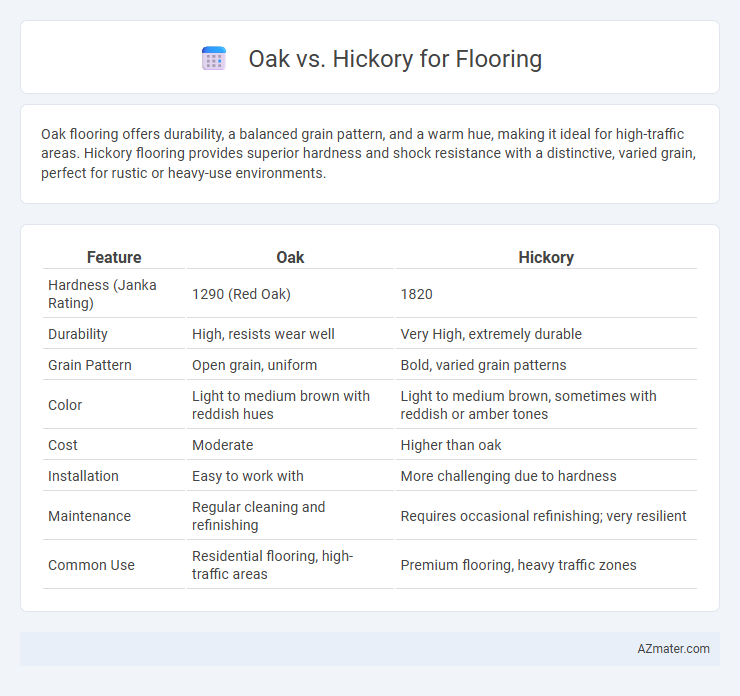Oak flooring offers durability, a balanced grain pattern, and a warm hue, making it ideal for high-traffic areas. Hickory flooring provides superior hardness and shock resistance with a distinctive, varied grain, perfect for rustic or heavy-use environments.
Table of Comparison
| Feature | Oak | Hickory |
|---|---|---|
| Hardness (Janka Rating) | 1290 (Red Oak) | 1820 |
| Durability | High, resists wear well | Very High, extremely durable |
| Grain Pattern | Open grain, uniform | Bold, varied grain patterns |
| Color | Light to medium brown with reddish hues | Light to medium brown, sometimes with reddish or amber tones |
| Cost | Moderate | Higher than oak |
| Installation | Easy to work with | More challenging due to hardness |
| Maintenance | Regular cleaning and refinishing | Requires occasional refinishing; very resilient |
| Common Use | Residential flooring, high-traffic areas | Premium flooring, heavy traffic zones |
Oak vs Hickory Flooring: An Overview
Oak flooring offers a classic look with a medium to light color palette, known for its durability and smooth grain patterns, making it a popular choice in traditional and contemporary interiors. Hickory flooring features a more varied and pronounced grain with higher hardness ratings, providing exceptional resistance to dents and scratches, suitable for high-traffic areas and rustic designs. Both hardwoods provide long-lasting performance, but hickory's superior hardness and unique character make it ideal for those seeking durability and distinctive aesthetics in flooring.
Appearance and Grain: Comparing Oak and Hickory
Oak flooring features a consistent grain pattern with a smooth texture, offering warm tones that range from light tan to medium brown, making it a versatile choice for various interior styles. Hickory displays a more pronounced, varied grain with contrasting streaks and knots, showcasing a rustic, natural character with colors from creamy white to rich reddish-brown. The distinct grain and color variation in hickory add visual interest and uniqueness to flooring, while oak provides a classic, uniform look favored in traditional and contemporary designs.
Durability and Hardness: Which is Tougher?
Oak and hickory are both popular hardwoods for flooring, with hickory ranking higher on the Janka hardness scale at approximately 1820 compared to oak's 1290 for red oak and 1360 for white oak. This higher hardness translates to greater resistance to dents and wear, making hickory tougher and more durable in high-traffic areas. While oak offers excellent durability and a classic look, hickory's superior hardness makes it the preferred choice for those seeking maximum toughness and longevity in flooring.
Color Variations: Oak vs Hickory Flooring
Oak flooring offers a wide range of color variations from light beige to medium brown with subtle reddish tones, providing a versatile and classic appearance. Hickory flooring features more pronounced color contrasts, ranging from pale cream to deep reddish-brown, creating a dynamic and rustic aesthetic. The distinct color variations in hickory enhance natural character, while oak's consistent hues lend a timeless elegance to interior spaces.
Cost Comparison: Oak vs Hickory
Hickory flooring typically costs more than oak, with average prices ranging from $5 to $12 per square foot, compared to oak's $3 to $9 per square foot. The higher cost of hickory is attributed to its durability and unique grain patterns, which add value to premium installations. Oak remains a more budget-friendly option while offering good hardness and a wide variety of finishes for versatile interior design.
Installation Process: Differences to Consider
Oak flooring typically offers easier installation due to its consistent grain and density, making it more forgiving for nail-down or glue-down methods. Hickory's hardness and pronounced grain can complicate installation, often requiring specialized tools and careful acclimatization to prevent cracking or warping. Professionals emphasize that Hickory demands precise subfloor preparation and moisture control to ensure long-term durability compared to Oak.
Maintenance and Cleaning Requirements
Oak flooring requires moderate maintenance with regular sweeping and occasional mopping using a damp cloth to prevent dirt buildup and preserve its finish. Hickory floors demand slightly more attention due to their hardness and grain variation, necessitating frequent dusting and specialized wood cleaners to avoid surface damage. Both hardwoods benefit from periodic refinishing to maintain their durability and aesthetic appeal over time.
Suitability for Different Interior Styles
Oak flooring offers timeless versatility with its light to medium tones and prominent grain patterns, making it suitable for traditional, rustic, and contemporary interiors. Hickory, known for its distinctive contrasting colors and durability, complements eclectic, farmhouse, and industrial styles by adding texture and warmth. Both woods provide strong wear resistance, but oak's smoother grain fits elegant spaces, while hickory's rugged appearance enhances casual, high-traffic rooms.
Environmental Impact and Sustainability
Oak flooring is widely recognized for its sustainability, as it is a fast-growing hardwood with efficient carbon sequestration and abundant availability in North America. Hickory, while also durable and strong, typically has a slower growth rate, leading to longer regeneration cycles and potentially greater environmental impact if not sourced responsibly. Choosing FSC-certified oak or hickory wood ensures adherence to sustainable forest management practices, minimizing ecological footprint and promoting biodiversity conservation.
Pros and Cons: Oak vs Hickory Flooring
Oak flooring offers exceptional durability and a classic grain pattern that enhances traditional and modern interiors, with moderate hardness ranking around 1290 on the Janka scale, making it resistant to dents and scratches. Hickory flooring surpasses oak in toughness, with a higher Janka hardness of 1820, providing superior resistance to wear and tear but may exhibit more prominent color variations that require careful selection for a uniform look. While oak is generally more affordable and widely available, hickory's robust hardness and striking appearance make it ideal for high-traffic areas, though its cost and variable coloration can be drawbacks for some homeowners.

Infographic: Oak vs Hickory for Flooring
 azmater.com
azmater.com